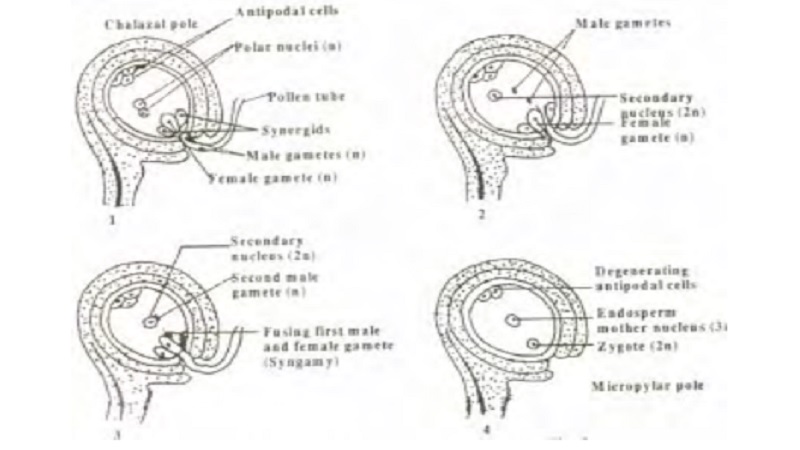Chapter: 11 th 12th std standard Bio Botany plant tree Biology Higher secondary school College Notes
Plant Reproduction : Double fertilization

Plant Reproduction : Double fertilization
The fusion of the male and female gametes is called fertilization. The process was first discovered by Strasburger (1884) in Monotropa
Siphonogamy
In seed plants, the male gametes arebrought to the eff containing female gametophyte by a pollen tube, the phenomenon is calledsiphonogamy.
Type of pollen entry
The pollen tube enters the ovule either through the micropyle (Porogamy eg. Lily), Chalaza (Chalazogamy eg. Cauarinas) or the integuments (Mesogamy-eg. cucurbita) and and discharges the two male gametes or sperms into the embryo sac. The pollen tube bores through nucellus and finally penetrates the wall of the embryo sac. It passes between a synergid and the egg cell or penetrates between the two synergids. Later one or both of the synergids degenerate. Inside the embryo sac, the pollen tube ruptures and the two male gametes are set free near the egg apparatus.
Syngamy or true fertilization
Out of the two male gametes, one fuses with the egg nucleus and forms a diploid zygote. This process of gametic fusion is calledsyngamy or true fertilization. It is also known as generative fertilization.
Triple fusion
The second male gamete moves further the central cell and fuses with the two haploid polar nuclei or diploid secondary nucleus to form a triploid primary endosperm nucleus. This process involving the fusion of three necle is called triple fusion. It is also calledvegetative fertilization. The central cell is now called primary endosperm cell.
The whole phenomenon of fertilization involving the fusion of one male gamete with the egg. together with the fusion of second male gamete with the polar nuclei is called double fertilization. It involves both syngamy and triple fusion. Double fertilization is a unique feature of angiosperm and is necessary and is necessary for the production of viable seeds in the flowering plants. It was first observed by Nawaschine(1898) in Fritillaria and Lillium.
Significance of double fertilization
Double fertilization is found to be universal occurrence among angiosperms. It must occur within the ovule for the setting of viable seeds. Following are the significance of double fertilization.
1. In angiosperms the growth of the embryo sac (female gametophyte) stops at 8 nucleate or 7 celled stage. The fusion of second male gamete with the polar nuclei or secondary nucleus, provides stimulus to one of its cells to resume growth and form the nutritive tissue or endosperm.
2. Double fertilizationensures that the nutritive tissue or endosperm is formed only when the formation of embryo has been confirmed by fertilization of egg. If fertilization fails due to some reason, no endosperm will be formed. Thus no energy of the plant will be wasted on this account in angiosperms.
3. It provides characteristics tonutritive tissue called endosperm.
Post fertilization changes
After fertilization the sepals,petals, stamens, styles and stigma usually wither and fall off. The calyx may persis(e.g. tomato, brinjal) and even show growth (eg. Physalis). The zygote undergoes a number of mitotic divisions and forms a multicellularembryo.The primary endosperm nucleus also undergo mitotic division to form a food laden tissue called endosperm. The ovules mature into seeds and the ovary containing the ovules enlarges and forms the fruit.
Parts before Parts after
fertilization fertilization
1. ovary -fruit
2. ovary wall -pericarp
3. ovule -seed
4. funicle -stalk of the seed
5. hilum -hilum
6. nucellus -perisperm
7. outer integument -testa Seed coat
8. inner integument -tegmen
9. micropyle -micropyle
10.Fertilized egg -Emdosperm
11.Synergids -Degenerate
12.Fertilized Secondary nucleus
13.Antipodal cells -Degenerate
Related Topics